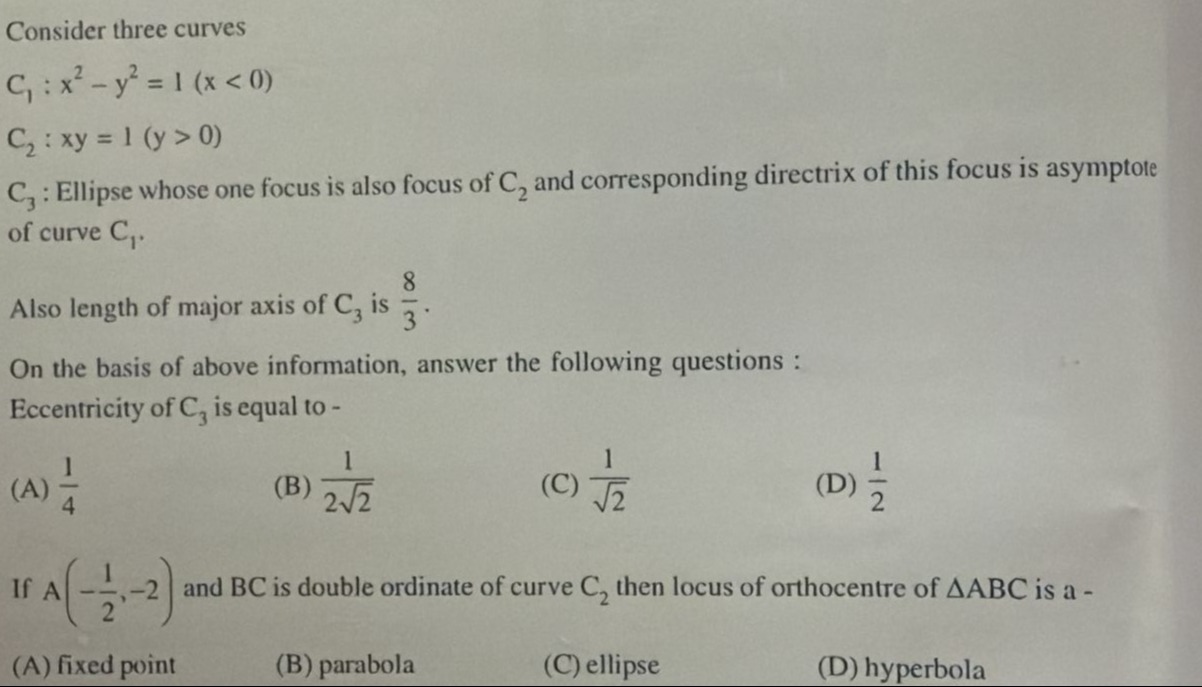Question
Question: Consider three curves $C_1: x^2 - y^2 = 1 (x < 0)$ $C_2: xy = 1 (y > 0)$ $C_3$: Ellipse whose one...
Consider three curves
C1:x2−y2=1(x<0)
C2:xy=1(y>0)
C3: Ellipse whose one focus is also focus of C2 and corresponding directrix of this focus is asymptote of curve C1.
Also length of major axis of C3 is 38.
On the basis of above information, answer the following questions: Eccentricity of C3 is equal to -

41
221
21
21
21
Solution
The problem involves three curves C1,C2,C3.
C1:x2−y2=1(x<0). This is a hyperbola. The asymptotes are y=±x.
C2:xy=1(y>0). This is a rectangular hyperbola. The foci are (2,2) and (−2,−2). The corresponding directrices are x+y=2 and x+y=−2.
C3: Ellipse. One focus F3 is a focus of C2, and the corresponding directrix d3 is an asymptote of C1.
Let F3 be a focus of C2. So F3=(2,2) or (−2,−2).
Let d3 be an asymptote of C1. So d3 is y=x (i.e., x−y=0) or y=−x (i.e., x+y=0).
The distance from a focus to its corresponding directrix is d. For an ellipse with semi-major axis a and eccentricity e, this distance is d=ea−ae=a(e1−e).
The distance from F3 to d3 must be non-zero, as a focus cannot lie on its directrix.
If F3=(2,2) and d3:x−y=0, distance is 12+(−1)2∣2−2∣=0. Not possible.
If F3=(2,2) and d3:x+y=0, distance is 12+12∣2+2∣=222=2. Possible.
If F3=(−2,−2) and d3:x−y=0, distance is 12+(−1)2∣−2−(−2)∣=0. Not possible.
If F3=(−2,−2) and d3:x+y=0, distance is 12+12∣−2+(−2)∣=2∣−22∣=2. Possible.
So, the distance from the focus to the directrix is d=2.
The length of the major axis of C3 is 2a=38, so a=34.
Using the relation d=a(e1−e), we have 2=34(e1−e).
23=e1−e=e1−e2.
3e=2(1−e2)=2−2e2.
2e2+3e−2=0.
This is a quadratic equation in e. Using the quadratic formula:
e=2(2)−3±32−4(2)(−2)=4−3±9+16=4−3±25=4−3±5.
Since eccentricity e must be positive for an ellipse (0<e<1), we take the positive root:
e=4−3+5=42=21.
The eccentricity of C3 is 21.
